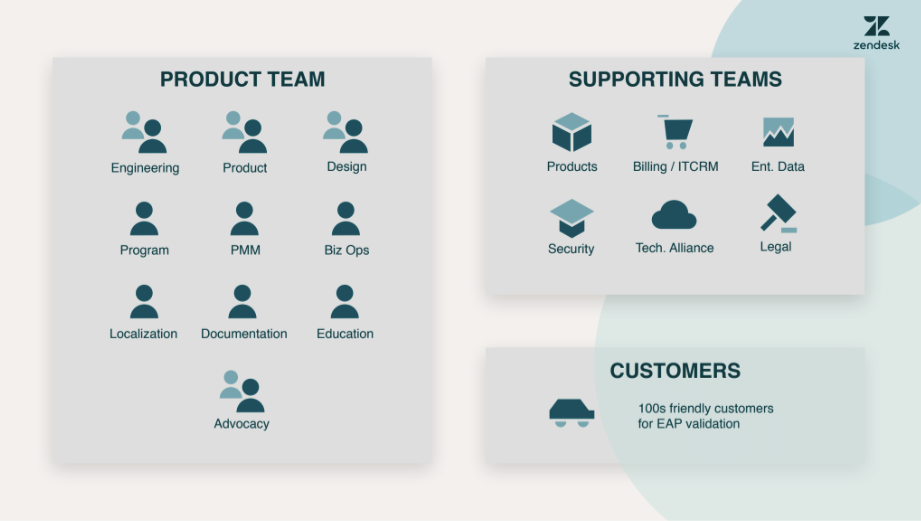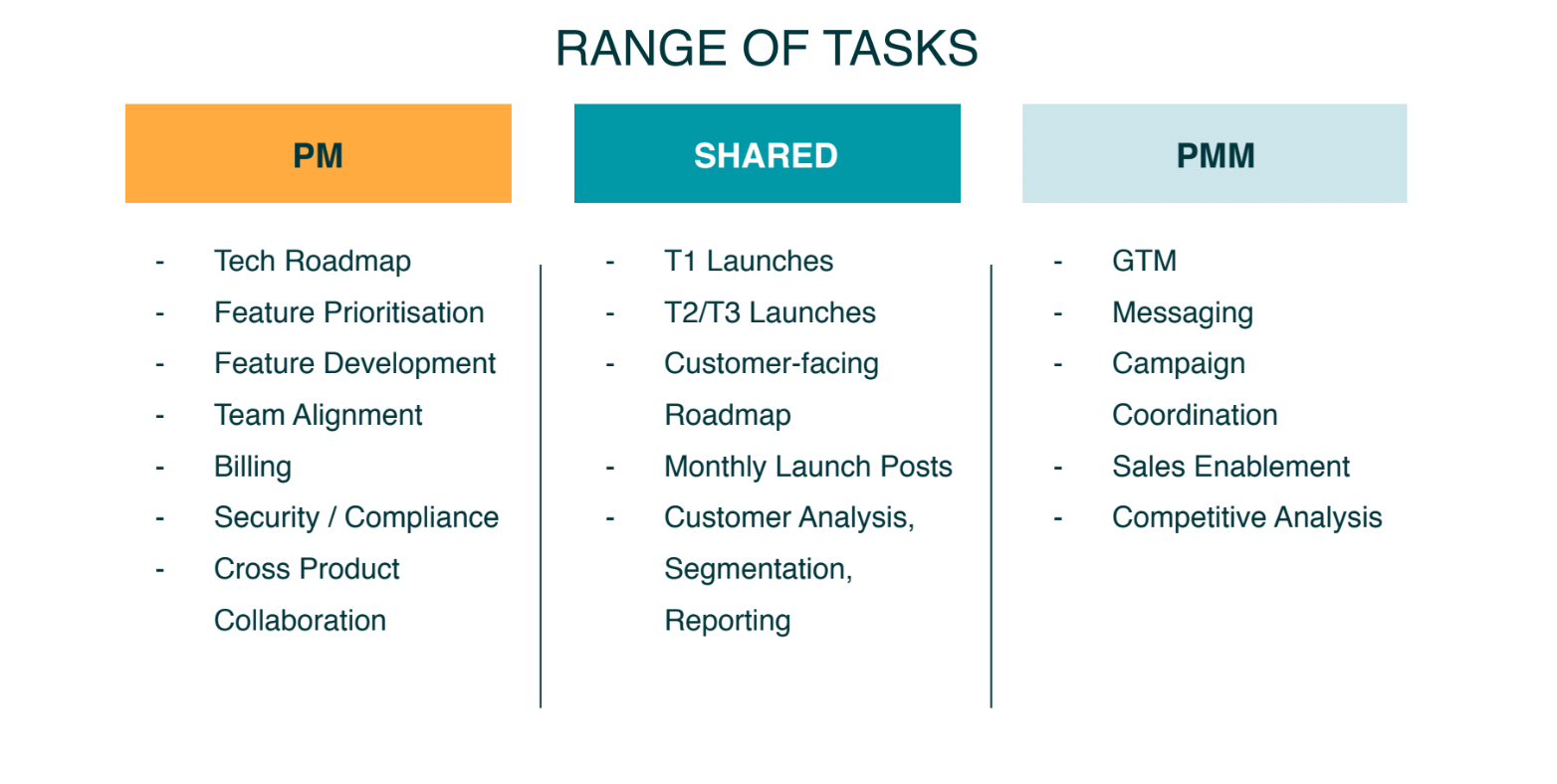Caroline Hynes, Director of Product at Zendesk, begins to unravel the complex, and in her eyes, too easily forgotten relationship between the PM and PMM. She offers her experience in making this partnership as fruitful as possible, and in the process, building the best product possible.
This article is adapted from Caroline's session at the Product-Led Summit, London 2019.
“The fact that I'm the eldest of five children, might be what has spurred on my interest in people. From what motivates us to how we can encourage people what we'd like them to do. That extended into when I was thinking about college. I very much wanted to work where I could focus on what I was good at. But, I would work with people who are better at other things than I was so that I could leverage their experience. Ultimately, we're perfectly imperfect. But how can we all actually come together to create brilliant products and brilliant experiences for our customers?
Product people and building relationships
The first relationship usually addressed when talking about product is that between the product team and the Engineers. We talk about this relationship at nauseum.
It needs to work because we need to have efficient teams and we need to have a shared understanding of the problem that we're solving. We need to get aligned on the solutions that we're implementing.
This is an image that we use to help us build products at Zendesk.

It takes an army to build a product, and to not only build it but to maintain it. We have a broader product team that doesn't just include product management or engineering design. It also includes people doing our documentation, our education, our translations, our product marketing. We then have the supporting teams around billing, legal, support, all of those things.
And ultimately, we have our customers as well, who are there to help us validate our assumptions and give us feedback. We're in this massive system. We've moved over time with our engineering and product design colleagues from a waterfall process into this agile process. We're trying to remove those handoffs, we're trying to reduce gaps in knowledge. It’s my assertion that we've done that really well within the Product Development and Engineering world.
But I really believe that there's a trifecta part of this relationship to make great products and customer experiences. And that is working with our Product Marketing Managers. And we don't focus on that relationship to the same extent that we focus on our engineering partnership.
Product Management and Product Marketing
It usually manifests when we build a feature or product. As PM's, we're delighted with ourselves. We say,
'Hey! Product Marketer, can you go talk about this? Here's some documentation. You can go and read and find out about it.’
That's not good for the product. It's not good for the customer. It's not good for our teams.
Your Product Marketers don't necessarily have all the context. But they're tasked with going and building a communication plan and engaging your customers.
So, what gets pushed out is borderline vaporware and there's severe gaps in information. The product team is left saying,
'That's not what we've built’ or ‘That's a version of what we built.'
A worse example might be that you're working hard on a feature. You release it, but you haven't partnered with your marketing partner.
Tumbleweed. There's no communication. Your customers can't find out about it. The team is left thinking,
‘What are we doing if we're not even talking about it to our prospects?’
The importance of the Product Marketer is paramount (click here to read a little more about their role), but what we need to focus on is really working on bridging this gap of communication to ensure they are able to fulfil their job as best they can.
There are two main areas as to why there are challenges between the PM and the PMM relationship.
Unclear roles and responsibilities
This is a real sticking point and I've been in organizations where I've spent most of my time trying to clarify these.
The amount of friction involved in determining these roles might depend on the personalities in the relationship. It might also depend on how much trust there is between the pair. It also depends on the organization. There is, realistically, a lot to be considering.
Lack of a shared goal
Another reason I've witnessed as a cause of stress between PM and PMM, is lack of alignment as to why we're focussing on solving a certain problem. When there isn't a shared KPI, you've got different motivators pulling the PM and the PMM in different ways. The PMM may be measured on how successful a campaign is, whereas a PM could be measured on shipping.
How can we begin to address this?
When we think about the difference between the role of a PM and the role of a PMM, it boils down to a very crude statement.
The PM doesn't do marketing.
That is the most black and white way of looking at it. But there are very clear tactical areas for both teams to be working on.
A good way to think about it is that the PM is responsible primarily for driving the internal team and the internal product development. Whereas, our PMM is responsible for communicating externally and with our customers (click here to see what PMMs actually have to say about being PMMs).
Let's look at the customer side, and think about the PMM. Some of the tactical work that they complete revolves around campaigns, sales enablement, positioning and marketing. And then if we look at our PM roles, their tactical work centers on product, feature prioritization, trade offs and team alignment.
Sharing is caring
But, the real benefit of these roles working hand in glove is where there is overlap in the work that they do. Those areas may include: your roadmap, your go-to- market planning and also looking at how you're going to talk about your products to your customers. (If you're interested to read more about this overlap, click here).
But for now, take a look at the table below.

At Zendesk, we ensure to include these shared components to our roles. Our customer facing roadmap is a shared activity. Our monthly launch posts are not just left to our PMM, but our product team are very much involved. We are both tasked with understanding our customer via analysis, segmentation and reporting. Shared tasks make for better communication, better understanding of eachother's roles and an appreciation of the other person's style of work. Use these opporunities to learn.
Room for movement
Just because you're in a specific role doesn't mean you can’t have an interest in another area. You could be a Product Marketer who has an interest in components of Product Management side or vice versa. If you've got flexibility, there's potential opportunities for you to dip into that.When you have that trust and that relationship, and you understand the roles responsibilities, you're able to dip in and help as needed across the organization.
We have very clear roles and responsibilities, but also there's a gray area. We're not so rigid that we cannot change. People aren't boxed in. Our Product Marketers are deliberately part of our product leadership team. They're part of all the conversations. They're advising us and they're giving us ideas. Our PMMs will answer questions from our support teams and on behalf of our customers almost more frequently than the product team because they are so involved and so engaged.
We then are able to actively encourage the different perspectives that our Product Marketing partners bring to the table. They look at things differently to the Product Management which adds so much value for our product and for our customers.
Product is King
We now spent zero time talking about 'That's my job' or 'That's not my target'.
We are instead asking,
‘How can we make our product better?
For us, that's both the focus and the driving force.

Team mentality
We think of our Product Marketing and our Product Management as a team, with our Engineers and our Product Designers. It's not just something we put pretty pictures up about. It's something that we work hard at. We have Product Management in San Francisco, in Dublin and in the South of France. We do not allow the tyranny of distance to become a barrier for us working effectively together. And we are highly effective.
‘Only when diverse perspectives are included, respected and valued, can we start to get a full picture of the world, and we translate that into building a more rounded product and into building a more rounded campaign and building better experiences for our customers.’
Brené Brown, researcher at University of Houston
The outcome?
Complete depth of knowledge
We now have alignment up and down our organization. If someone in our San Francisco office speaks to our PMM, and they ask him why something is or is not on the roadmap, he will be able to answer. He will not need to go back and check with the product team. If that same person was to ask any of the Explore product managers why we are or not doing something, they will get the same answer. That is incredibly powerful. That translates then to when we're answering customer questions in our support team or answering other team questions about the product. We can trust that our Product Marketing partners and our product team will be saying the same thing. This gives us freedom, and it gives scale across the organization as our product and our actual footprint grows with our customers as well.
To take from this?
How much time have you actually invested in building a meaningful, deliberate relationship with your Product Marketer or your Product Manager? How well understood are the roles and responsibilities? And can you create that gray area so people can grow and pivot a little bit? If you can allow people to grow and mature, this will bring your product forward. And all of that ultimately, is boiled down because we all build products. We all love to build and promote and talk about product. Because we love our customers, and we want our customers to have a great experience."
Caroline started her career in the first.com boom in San Francisco, learning her trade in startups. She's worked in various industries across the US and the UK. Disney, British Telecom, Paddy Power and intercom, working both on the delivery side of products but also on Product Management.



